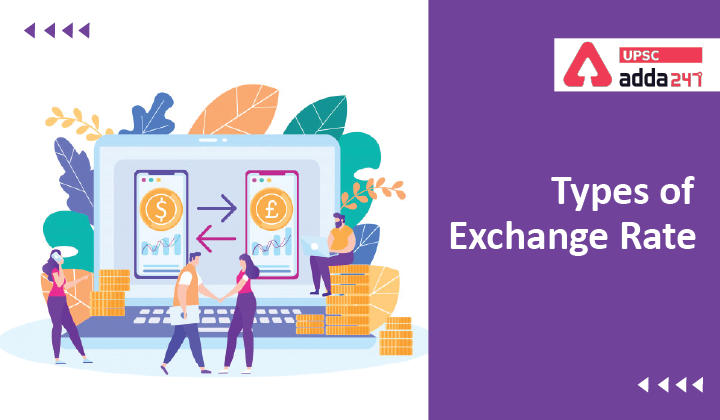Table of Contents
Types of Exchange Rate
Freely floating exchange rate
- It is the is the simplest type of system as the rate is freely determined by market forces, and the monetary authorities refuse any intervention in the exchange rate market.
- In this system, the rate can fluctuate by any amount at any moment.
- Flexible exchange rates are determined daily in the market by the forces of demand and supply, without any restrictions imposed by governmental policy.
- Advantages: Highly transparent and highly efficient market.
Get Free Study Material for UPSC and State PCS Examinations
Fixed exchange rate
- In a fixed exchange rate regime, exchange rates are held constant or allowed to fluctuate within very narrow boundaries, perhaps 1 percent above or below the initial set of rates.
- When a country chooses to fix its exchange rate, local currency is assigned a par value in terms of gold, another currency, or a basket of currencies.
- When the exchange rate begins to move too much, the government intervenes with the devaluation or revaluation of its own currency against other currencies. The objective is to maintain the exchange rate within the specified boundaries.
- Such government intervention can either be direct or indirect.
- Direct intervention needs a change in international reserves.
- Sterilized direct intervention occurs when the central bank intervenes in the foreign exchange market while making adjustments to avoid a change in money supply; in other words, the central bank transacts simultaneously in foreign exchange markets and treasury securities markets.
- Indirect intervention is affected by influencing the factors that determine exchange rates through increasing or decreasing interest rates or other economic indicators (income, inflation, etc.). This move does not involve a change in reserves.
- Examples of fixed exchange regimes include the systems established by the Bretton Woods Agreement from 1944 to 1971 and the Euro zone between 1999 and 2002.
Pegged exchange rate
- Countries operating under a pegged exchange rate regime “peg” their currency’s value to a foreign currency or some unit of account (e.g., gold, the European currency unit, etc.).
- Hence, while bilateral parity is maintained, the home currency’s value fluctuates against other currencies in line with the anchor country’s currency.
- In this system, market forces determine the exchange rate.
- If the exchange rate moves above or below the predetermined limits, the government will intervene to move the price of the currency back within the tolerable zone.
- Advantages of pegged exchange rate: Some countries favour a pegged exchange rate because it enhances the credibility of the government’s commitment to low inflation.
Managed float exchange rate
- A managed floating exchange rate (also known as dirty float’) is an exchange rate regime in which the exchange rate is neither entirely free (or floating) nor fixed.
- Rather, the value of the currency is kept in a range against another currency (or against a basket of currencies) by central bank intervention.
- It resembles the freely floating exchange rate in the sense that exchange rates can fluctuate on a daily basis and official boundaries do not exist.
- The difference is that the government can intervene in order to prevent the currency rate from fluctuating much in a certain direction.
- Under a managed float, the goal is to prevent sharp fluctuations in the short run, but intervention does not target any particular rate over the long run.
- A managed floating exchange rate gives the central bank the power to set a corridor for the exchange rate, in order to avoid situations of currency over- or under-valuation.
- Some governments impose bands within which the exchange rate can fluctuate, which is one of the reasons for calling this approach “dirty.”
Exchange rate regimes in the world
- Most developed countries of the world have freely floating exchange rate regimes wherein the central banks do not intervene in the foreign exchange markets to stabilise currency fluctuations.
- On the other hand, there are countries such as HongKong which have a fixed parity with the US dollar and the HongKong central bank uses its monetary policy to maintain this peg.
- Majority of the emerging economies lie somewhere in between these two extremes.
- They are mostly characterised by ‘managed floating’ exchange rate regimes or some version of a ‘pegged’ regime.
Exchange rate system in India
- In the post-independence period, India’s exchange rate policy has seen a shift from a par value system to a basket-peg and further to a managed float exchange rate system.
- With the breakdown of the Bretton Woods System in 1971, the rupee was linked with pound sterling.
- In order to overcome the weaknesses associated with a single currency peg and to ensure stability of the exchange rate, the rupee, with effect from September 1975, was pegged to a basket of currencies till the early 1990s.
- In 1993, India officially moved towards a “market determined exchange rate” from a fixed peg to the US dollar.
- This was part of the liberalisation and deregulation reforms of the early 1990s.
- There has been a currency market since then, and at the same time the Reserve Bank of India actively trades in this market.
- RBI has been intervening in the forex market to prevent the rupee from appreciating.
- IMF in 2004 has classified exchange rate India as “managed floating with no pre-determined path for the exchange rate”.





 TSPSC Group 1 Question Paper 2024, Downl...
TSPSC Group 1 Question Paper 2024, Downl...
 TSPSC Group 1 Answer key 2024 Out, Downl...
TSPSC Group 1 Answer key 2024 Out, Downl...
 UPSC Prelims 2024 Question Paper, Downlo...
UPSC Prelims 2024 Question Paper, Downlo...
